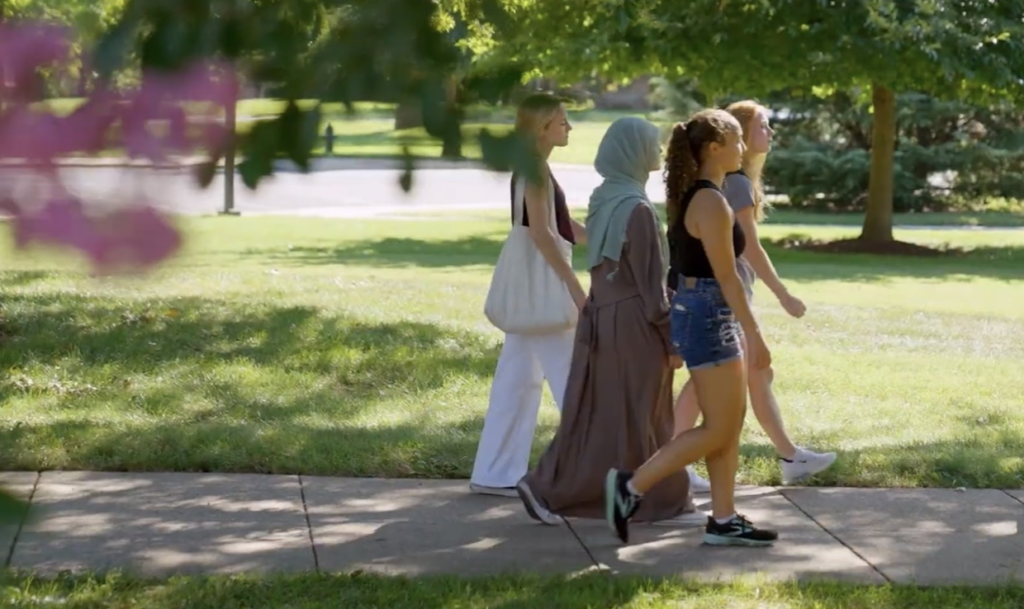Muslim Students Struggle to Find Places for Prayer and Community

Image Courtesy of The College Tour
By Mariah Solis
As a former international undergraduate student at CUA, Razan Bahabri remembers how when she was applying to colleges, she was originally considering another university in Washington, D.C., but was told that as a Muslim, she would not have a place to pray. That same day, she visited the Catholic University of America.
“The admissions person gave me her office to pray,” she recalled, “And that’s what made my decision to come to Catholic University.”
The Institutional Research and Assessment staff reports an estimated total of 98 Muslim students currently enrolled in CUA’s undergraduate and graduate programs but has previously amassed enrollment as high as 178 Muslim students in 2018. Many of these students are drawn to CUA for the same reasons as their peers: the beautiful campus, enticing academic programs, and appealing student organizations. Additionally, several Muslim students are attracted to the spiritual and religious nature of the school, especially since there are a multitude of commonalities between the two monotheistic, Abrahamic religions.
According to the Washington Post, Catholic universities have a greater population of Muslim students compared to other four-year universities in the United States. Some Catholic colleges respond to this influx of enrollment by hiring Islamic chaplains, designating a place for Muslims to pray, and even allowing students to form a Muslim Student Association (MSA). Other universities find themselves unsure of how to hold true to their Catholic identity while meeting the needs of their non-Catholic students.
Gudrun E. Kendon, Director for International Student and Scholar Services, has witnessed several students wanting and trying to officially start an MSA since she began working at CUA in 2007. She recalled a student from Saudi Arabia who applied to establish an MSA but was ultimately turned down. Since Saudi culture is heavily influenced by Islam, the students shifted gears and formed the Saudi Student Alliance (SSA). However, the SSA does not function the same way as an MSA, especially since Muslims are not a singular nationality, race, or ethnicity.
Last semester during the month of Ramadan, a sacred time on the Islamic calendar that involves daily fasting, the SSA was able to host an Interfaith Fasting Day every Tuesday.
“I was the president back then, and we had a lot of people of different religions come and share the meal with us,” said Bahabri, who is currently a teacher assistant pursuing her Ph.D. through Catholic University’s department of Biomedical Engineering.
Although there may be some interfaith events hosted by an organization or the school from time to time, there are not any established places for Muslim students to pray in. In the past, Muslim students have been told they can use the Basilica to pray; however, many of them are taught not to pray in places surrounded by a lot of religious objects, icons, and artwork.
Muslim students adhere to Salah praying times, which are done five times a day at specific times while bowing down and then laying prostrate, facing the Kaaba in Mecca. It is common for Muslim students to rush to an unoccupied classroom, or even reserve a conference room to pray. Some may even meet a professor or faculty member willing to offer up a space, as Baharbi did.
The admissions person that offered her own office to Bahabri extended the invitation to other Muslim students, and even provided snacks and refreshments in the room; however, the individual no longer works at the university. Confidential rooms like this have existed for a long time at CUA.
For years, professors and faculty members have designated a room or office for Muslim students to use for prayer. These spaces are always temporary, however, due to faculty and professors relocating or retiring. Moreover, not every Muslim student is aware of these places because of the culture of secrecy surrounding these instances. The lack of an official network for Muslim students to know and meet one another leaves many in the dark about possible places to go for prayer.
“To be honest, I used to have a hard time finding a corner to pray or to hide from others to pray. Of course, it’s a safe area to pray. Nobody has ever complained about me praying at all, but it would be nice to have that specific room because I know I’m gonna go there, instead of wasting my time finding an area to pray and hide,” shared Bahabri. “[O]ut of respect, I don’t want to pray in front of anyone. I don’t want to show off, ‘Hey, I’m praying!’”
Although this aspect of life on campus was tough for her, she does not have any negative regard for the university, since she believes the institution helped her grow academically for the past ten years of being a student at Catholic University.
She does believe that an established prayer space or meditation room for non-Catholics would increase enrollment, considering how it would make prospective students who are not Catholic feel equally welcomed.
“[T]hey will understand that it’s not just about the religion but about the education that we are going to have from this school,” she stated.
Not too long ago, there were plans amongst faculty to establish an official prayer room for non-Catholics. During the 2019-20 academic school year, students and staff attended an interfaith program to stimulate interreligious conversations about ways to be more hospitable to students of other faiths. Shortly after, Fr. Jude DeAngelo, the University Chaplain at the time, received requests for a space to pray from Muslims and other non-Catholic students. He came up with an interfaith room proposal for University Advancement, including a drawing of the space. He consulted university staff and administrators but asked for the plans to not be mentioned to others while he was working on them.
“We did have a potential donor before the pandemic, but ultimately they decided not to fund the project,” said Andrea Trisciuzzi, Associate Vice President for Strategic Initiatives.
Nevertheless, the Covid-19 pandemic put all plans on hold, and eventually the conversation surrounding an interfaith room dwindled.
During the 2022-23 academic year, however, students are once again initiating the conversation. At President Kilpatrick’s first town hall meeting, freshman biomedical engineering major Maysoon Obeid asked him what his plans were for students that are not Catholic, and even gave a personal anecdote about how admissions gave her the impression that she would have a place to pray. He responded by saying that the university he attended as a student had an interfaith center that he felt was a strong component of the school, and he wished to implement something similar at Catholic University. He mentioned how he has plans to remodel Pangborn Hall, and potentially have an interfaith space there, although he was unclear when that would be.
“President Kilpatrick is very welcoming. I met him at the Town Hall after I asked about his opinions about an interfaith praying area, and he was very supportive of it, and he wanted it to happen, but ultimately it is the decision of multiple people,” Obeid shared.
After Obeid reached out to other Muslim students, they all came to the realization that due to specific requirements that must be met to pray, it would be ideal if a specific praying area was designated for Muslim students.
“A Muslim cannot pray if anyone is standing in front of you or in close-distance in front of you, unless that person is praying and they are Muslim. So if we have an interfaith praying area, how can you ensure that while I’m praying, someone of a different religion doesn’t sit in front of me,” Obeid stated, sharing the concerns of other Muslim students. “Even if they are just sitting, or just standing, or just talking and walking in front of me, anyone that crosses my path while I’m praying: my prayer is invalid. That’s just one of the restrictions.”
Obeid also discussed how there may be cultural differences between Muslim students on campus. Those with a more conservative religious upbringing may not pray while men and women are both in the same room. This further complicates how an interfaith space could function and is part of why other institutions like the University of Notre Dame and Georgetown University have an MSA and designated prayer space for Muslims.
A distinction between these Catholic institutions and the Catholic University of America is its inclusion in The Newman Guide as one of the twenty-two colleges recognized by The Cardinal Newman Society for having a strong Catholic identity. While the recommended schools do not receive funding from The Cardinal Newman Society, maintaining a place on the Newman Guide is important to the university.
“[T]he recommendations provided by the Society serve as another useful tool to assist potential students and their families in determining what college is best for them,” stated University Communications. “The Society’s recommendations provide guidance to students and their families to determine if these particular colleges match their values and needs.”
Obeid believes an official MSA would make more potential students feel welcomed, and it would provide a way for Muslim students to have community, gather for prayer, and even facilitate interreligious dialogue. Since she was featured in The College Tour for an episode about CUA, her desire to start an MSA is mentioned on the university’s website. Her university profile talks about how she hopes an MSA would “be focused on tolerance, appreciating differences, and perhaps most important, ‘finding our similarities as people.’”
“[I]t would be like a community where all the Muslim students are aware of, so we could all go to it, go to the meetings, and actually meet each other and help each other throughout our journey, ” Obeid said.
Obeid believes an established MSA on campus would serve as a way to continue Muslim-Christian dialogue.
“I feel like it is also beneficial to the CUA community in general. Having an MSA is basically like a communication between the Catholic students and the Muslim students, so we plan on having collaborations with some of the many catholic organizations on campus. I feel like that’s a demonstration of the religious peace that could happen in the real world. I feel like it’s also important that we can teach others about our religion and show that a lot of the stereotypes are not true.”
Obeid submitted her application to start an MSA to the Office of Campus Activities at the beginning of the semester, where it was put on hold for a month. Afterward, she had to meet with Dean Kathryn Jennings to discuss the details before preparing for a meeting with President Kilpatrick and Fr. Aquinas Guilbeau, O.P.., University Chaplain and Director of Campus Ministry.
Obeid is extremely grateful that the school has been taking the time to fully consider her proposals and listen to her concerns. She shared how she chose Catholic University because of religious reasons, recognizing the commonalities Christianity has with Islam, in addition to the opportunities within the engineering program.
“Since starting here at CUA, I have not faced any prejudice, comments, racism, or islamophobia from any students to be honest; Everyone’s been really kind, really welcoming,” Obeid said while reflecting on her first semester.
With new student initiatives and President Kilpatrick’s interest, students and staff wait to see if the spring semester brings further development to this evolving discussion.






